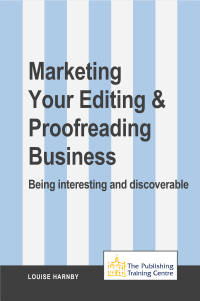 By Amy Haagsma
By Amy Haagsma
Louise Harnby touts this as “a book for editorial business owners, by an editorial business owner.” She promises that it is not a marketing textbook and that she’s done her best to avoid using jargon; rather, she’s tried to give editorial professionals real advice in the same manner she would in a face-to-face conversation.
Even the introduction is packed full of useful information, and the first item Harnby tackles is dispelling the notion that editors and proofreaders are not marketers. Everyone, she says, is a marketer, and having a marketing strategy is essential. After you’ve invested time and money in setting up your business, marketing is the next step to help you find clients and sell your services. Being good at what you do is not enough; you need to be found in order to be successful. Once you have built up your client base, regular marketing helps you stay in the minds of your clients.
Harnby also looks at a number of definitions of marketing, followed by her own: “being interesting and discoverable.” She recommends striving for this with everything you do, from ordering business cards to responding to an inquiry from a client. She also acknowledges the tendency for editors and proofreaders to be introverted, emphasizing that your marketing plan should suit your personality.
The remainder of the book is broken down into four sections:
- Marketing concepts—things to think about
- Marketing activities—things to do
- Sample outline of a marketing plan
- Resources
Harnby recommends working through part 1 first, especially if you are new to or nervous about marketing, and then going through part 2 in any order that appeals to you.
The first two chapters are focused on identifying what services you’ll offer and whom you’ll target as prospective clients, topics introduced in Harnby’s previous book. Now, she covers them from a different angle, such as how to communicate your service offering to your clients in terms they will understand and how to help clients see the role that editors and proofreaders have in producing a high-quality product.
The rest of part 1 guides you through developing your marketing content and strategy. As a basis for your content, you’ll write hooks (elements that capture your clients’ attention), unique selling points (your key selling points and differentiators), pitches (specific details about what you do and for whom), and calls to action (directive messages that compel clients to take a specific action). Harnby also explains how to communicate your value to clients and how to focus your message by putting yourself in your clients’ shoes. Elements of strategy include things like marketing through a variety of channels, setting goals and priorities, and building your brand.
Harnby also advocates for an integrated or “joined-up” approach to your marketing, in which everything you do is interconnected. For example, once you’ve determined whom your clients might be (chapter 2), you can then develop the hooks, unique selling points, pitches, and calls to action that will appeal to them (chapter 4), while thinking of ways to add value (chapter 8). One of the ways Harnby has provided value for her self-publishing clients is by offering a free ebook, Guidelines for New Authors.
In part 2, she covers a wide range of marketing activities, as well as why and how to implement them, the level of effort required to do so, and numerous tips and tricks. There is a mix of passive activities, which are designed to bring clients to you, and active activities, which take you to them. Harnby also offers very current advice about responsive website design, social media, and blogging, but advocates using these to complement, rather than replace, more traditional marketing strategies. In fact, she mentions cold letters as one of her preferred methods of contact for certain types of clients.
Again, Harnby emphasizes the idea that all of the pieces of your marketing are interconnected. Your marketing activities are connected to the concepts from part 1 as well as to each other. If you are setting up a website (chapter 14), you’ll likely want to incorporate your blog (chapter 16), your online portfolio (chapter 23), and client testimonials (chapter 24). You may also wish to include a downloadable resumé (chapter 21), links to your social media profiles (chapter 15), and links to online directory listings (chapter 19).
Following this comprehensive discussion of marketing concepts and activities, part 3 is a sample marketing plan for a (fictitious) new entrant to the field. Harnby has chosen to profile someone with a non-traditional background, which serves as a great example of how to use your unique skills and experience as assets in your marketing.
Part 4 is an extensive resources section, covering everything from public speaking to using Twitter lists. The book is clearly well-researched, and I am eager to read many of the articles and books listed as cited works. Harnby has also included sections for tools and other online resources, blogs and resource hubs, and editorial societies.
Marketing Your Editing & Proofreading Business has been a welcome addition to my editorial bookshelf. It is considerably longer than Business Planning for Editorial Freelancers but was also very enjoyable to read. Each chapter builds on the ones before, and many points are followed by case studies, real or fictitious examples of what an editorial professional has done or might do. Harnby has also summarized key points at the end of each chapter and included a “try this!” suggestion—a specific task based on what she has covered in the chapter.
Harnby has put together a collection of excellent advice for anyone who is starting out or who would like to give their business a boost. It is evident that she employs these strategies herself, as demonstrated by her website, blog, social media presence, and more, which adds to her credibility.
For more information and a detailed table of contents, see Harnby’s website.
Amy Haagsma is a marketing communications professional and a graduate of SFU’s Editing Certificate program.
This article was copy edited by Meagan Kus. It was originally published on West Coast Editor, the official blog of the EAC’s B.C. branch.
